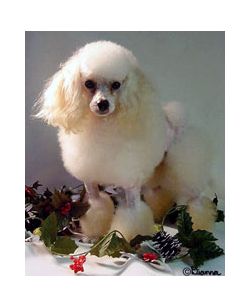Toy Poodle Dog Breed
Aliases: Tea Cup poodle
Description
The Toy Poodle is a very energetic, intelligent, and elegant appearing small dog. It has a beautiful dens, curly, and harsh textured coat. Most coats are solid throughout. The ears are long, wide, thickly feathered and hang close to the head. The skull is moderately rounded with a long, straight muzzle. Jaws are strong with a scissor bite. Their eyes are oval in shape, and usually dark in color. Neck and shoulders are strong and long enough to carry the head high with dignity. The body has a muscular squarely built appearance. The chest is deep and wide with well-sprung ribs. The top line of the back is level from the shoulder blades to base of tail. The bones and muscles of both hind legs and forelegs are in proportion to its size. The tail is straight and carried up sometimes docked of length to insure a balanced outline. Their feet are rather small and oval in shape. Toes are arched, with thick hard pads for good cushioning. Dewclaws are generally removed.
Toy Poodles make very rewarding pets. In spite of their small size, the Toy Poodle has retained the independent personality of large Poodles, and is an affectionate, playful companion.
Coat Description
The Toy Poodle has a beautiful coat that is a single layer and completely non-shedding. It does need to be groomed every 6-8 weeks to keep the coat free of mats. They should be bath frequently and brushed a few times a week.
History
Poodles are supposed to have originated in Germany, where it is known as the Pudel or Canis Familiaris. The English word Poodle comes from the German Pudel , meaning to splash in the water. However for years it has been regarded as the national dog of France, where it was commonly used as a retriever as well as a traveling-circus trick dog. In France it is known as the Caniche, or duck dog. It is known that this breed has been around for at least 400 years throughout Western Europe. Despite the conversey France has now been officially recognized as its country of origin.
The Poodle\'s distinctive looks have made it a popular subject for paintings, dating back to the 15th century. In the 18th and 19th centuries, the Poodle could be seen in circuses throughout Europe and America performing a variety of tricks. The French artist Henri de Toulouse-Lautrec did a series of drawing and paintings of the breed. The Toy Poodle was breed down from the Standard and Miniature Poodle. This breed has become one of the most popular dog breeds ever.
Temperament
The Toy Poodles intelligence is renowned; they can be taught all different tricks through various skill levels. They appear to enjoy performing and entertaining their owners. They are one of the easiest and brightest breeds to train. It is alert, responsive, playful, and eager to please.
While the standard Poodle has a high playfulness with other dogs the Toy poodle is a little less enthusiastic. Of course this is just in general and depends on the environments in which they are raised. They can be shy with strangers and should be socialized as a puppy. They tend to love children interaction with their owners. The Toy Poodle is not considered as a "yappy" dog. They will bark to defend or warn their owners but tend to be more reserved then other small toy breeds. Although they are high in excitement they don\'t seem to be a destructive type when left alone. Some dogs when left alone at home can damage items out of boredom or anxiety. This tends not to be the case with Toy Poodles as long as they get sufficient amount of exercise and companion. Some bloodlines may be high strung and are more liable to react nervously to new circumstances. Generally Toy Poodles are devoted to their family and have a friendly, cheerful disposition.
Thyroid Disease - Low Risk
The Toy Poodle ranks #101 among all breeds for autoimmune thyroiditis prevalence. This is considered a low risk breed so your chances of obtaining a dog with the disease is small. It is still suggested that dogs meant for breeding still be tested to help bring the incidence of disease even lower (or even eliminate it).
| Rank Among Breeds |
Number of Dogs Tested |
Percent of Dogs With Disease |
| #101 |
731 |
3.1% |
You can download the full report (on all breeds) by the Michigan State University Diagnostic Center for Population and Animal Health. Here
Other Health Problems
Some Toy Poodles may be more prone to eye diseases such as; cataracts, glaucoma, and retinal disease. Also more concerning problems may include, legg perthes disease, gastric torsion, and sebaceous adenitis. With many other breeds it is always good to watch out for gum disease, ear infections, and parasites.

